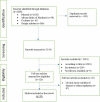Prevalence and factors associated with maternal and neonatal sepsis in sub-Saharan Africa: a systematic review and meta-analysis
- PMID: 38327574
- PMCID: PMC10847291
- DOI: 10.3389/fpubh.2024.1272193
Prevalence and factors associated with maternal and neonatal sepsis in sub-Saharan Africa: a systematic review and meta-analysis
Abstract
Objectives: This study aimed to determine the prevalence and factors associated with maternal and neonatal sepsis in sub-Saharan Africa.
Methods: This systematic review and meta-analysis used the PRISMA guideline on sepsis data in sub-Saharan Africa. The bibliographic search was carried out on the following databases: Medline/PubMed, Cochrane Library, African Index Medicus, and Google Scholar. Additionally, the reference lists of the included studies were screened for potentially relevant studies. The last search was conducted on 15 October 2022. The Joanna Briggs Institute quality assessment checklist was applied for critical appraisal. Estimates of the prevalence of maternal and neonatal sepsis were pooled using a random-effects meta-analysis model. Heterogeneity between studies was estimated using the Q statistic and the I2 statistic. The funnel plot and Egger's regression test were used to assess the publication bias.
Results: A total of 39 studies were included in our review: 32 studies on neonatal sepsis and 7 studies on maternal sepsis. The overall pooled prevalence of maternal and neonatal sepsis in Sub-Saharan Africa was 19.21% (95% CI, 11.46-26.97) and 36.02% (CI: 26.68-45.36), respectively. The meta-analyses revealed that Apgar score < 7 (OR: 2.4, 95% CI: 1.6-3.5), meconium in the amniotic fluid (OR: 2.9, 95% CI: 1.8-4.5), prolonged rupture of membranes >12 h (OR: 2.8, 95% CI: 1.9-4.1), male sex (OR: 1.2, 95% CI: 1.1-1.4), intrapartum fever (OR: 2.4, 95% CI: 1.5-3.7), and history of urinary tract infection in the mother (OR: 2.7, 95% CI: 1.4-5.2) are factors associated with neonatal sepsis. Rural residence (OR: 2.3, 95% CI: 1.01-10.9), parity (OR: 0.5, 95% CI: 0.3-0.7), prolonged labor (OR: 3.4, 95% CI: 1.6-6.9), and multiple digital vaginal examinations (OR: 4.4, 95% CI: 1.3-14.3) were significantly associated with maternal sepsis.
Conclusion: The prevalence of maternal and neonatal sepsis was high in sub-Saharan Africa. Multiple factors associated with neonatal and maternal sepsis were identified. These factors could help in the prevention and development of strategies to combat maternal and neonatal sepsis. Given the high risk of bias and high heterogeneity, further high-quality research is needed in the sub-Saharan African context, including a meta-analysis of individual data.Systematic review registration: PROSPERO (ID: CRD42022382050).
Keywords: associated factors; maternal sepsis; neonatal sepsis; prevalence; sub-Saharan Africa.
Copyright © 2024 Traoré, Sidibé, Diallo, Camara, Sidibé, Diallo, Diarra, Ly, Ag Ahmed, Kayentao, Touré, Camara, Delamou, Sangho and Terera.
Conflict of interest statement
The authors declare that the research was conducted in the absence of any commercial or financial relationships that could be construed as a potential conflict of interest. The authors declared no conflicts of interest.
Figures





Similar articles
-
The burden of neonatal sepsis and its risk factors in Africa. a systematic review and meta-analysis.BMC Public Health. 2025 Mar 3;25(1):847. doi: 10.1186/s12889-025-22076-w. BMC Public Health. 2025. PMID: 40033243 Free PMC article.
-
The effect of gestational age, low birth weight and parity on birth asphyxia among neonates in sub-Saharan Africa: systematic review and meta-analysis: 2021.Ital J Pediatr. 2022 Jul 15;48(1):114. doi: 10.1186/s13052-022-01307-5. Ital J Pediatr. 2022. PMID: 35841063 Free PMC article.
-
Risk factors for neonatal sepsis in Sub-Saharan Africa: a systematic review with meta-analysis.BMJ Open. 2022 Sep 1;12(9):e054491. doi: 10.1136/bmjopen-2021-054491. BMJ Open. 2022. PMID: 36253895 Free PMC article.
-
Obstetric, foetal and neonatal outcomes in adolescent pregnancy in sub-Saharan Africa: Systematic review and meta-analysis protocol.PLoS One. 2025 May 9;20(5):e0323099. doi: 10.1371/journal.pone.0323099. eCollection 2025. PLoS One. 2025. PMID: 40344007 Free PMC article.
-
Burden of early neonatal mortality in Sub-Saharan Africa. A systematic review and meta-analysis.PLoS One. 2024 Jul 25;19(7):e0306297. doi: 10.1371/journal.pone.0306297. eCollection 2024. PLoS One. 2024. PMID: 39052580 Free PMC article.
Cited by
-
Neonatal Sepsis: Aetiology, Pathophysiology, Diagnostic Advances and Management Strategies.Clin Med Insights Pediatr. 2024 Sep 25;18:11795565241281337. doi: 10.1177/11795565241281337. eCollection 2024. Clin Med Insights Pediatr. 2024. PMID: 39371316 Free PMC article. Review.
-
Assessing patient-level risk factors for evidence-based early diagnosis of maternal sepsis.BMC Pregnancy Childbirth. 2025 Jul 22;25(1):782. doi: 10.1186/s12884-025-07895-4. BMC Pregnancy Childbirth. 2025. PMID: 40696302 Free PMC article.
-
Spatial variations and predictors of neonatal mortality among births to HIV-infected and non-infected mothers in rural Zambia.PLOS Glob Public Health. 2025 Jul 1;5(7):e0003331. doi: 10.1371/journal.pgph.0003331. eCollection 2025. PLOS Glob Public Health. 2025. PMID: 40591556 Free PMC article.
-
The burden of neonatal sepsis and its risk factors in Africa. a systematic review and meta-analysis.BMC Public Health. 2025 Mar 3;25(1):847. doi: 10.1186/s12889-025-22076-w. BMC Public Health. 2025. PMID: 40033243 Free PMC article.
-
Prevalence and factors associated with puerperal sepsis among postnatal women at a Tertiary Referral Hospital in Western Uganda.PLoS One. 2025 Aug 4;20(8):e0311708. doi: 10.1371/journal.pone.0311708. eCollection 2025. PLoS One. 2025. PMID: 40758656 Free PMC article.
References
Publication types
MeSH terms
LinkOut - more resources
Full Text Sources
Medical

